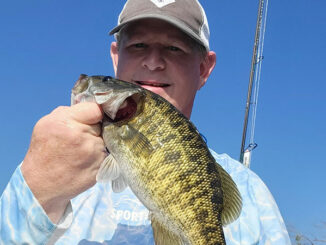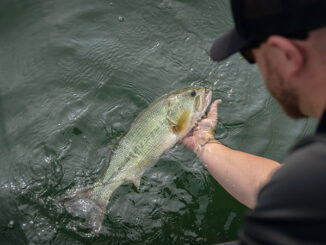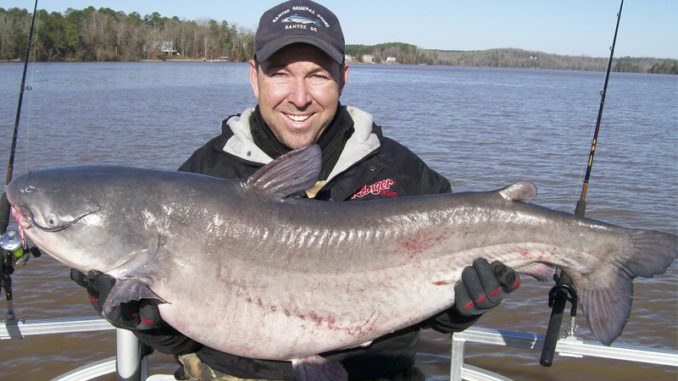
Try these five lakes in the Carolinas for top winter catfish action.
Gone are the days when catfish were delegated to warm weather and water for consistent fishing. With the introduction of blue catfish into many lakes and rivers in the Carolinas, the cold-weather catfishing game has changed significantly.
Blue catfish active during the cold months. And they literally gorge on forage such as gizzard and threadfin shad, as well as white perch so richly abundant in many lakes. This “consuming mass quantities of forage” trait enables anglers to target blue catfish effectively.
Not all lakes are created equal when it comes to blue catfish. And five lakes in the Carolinas stand out as top cold-weather catfish destinations. Take the advice of these experts, and your odds of consistent catches and an occasional trophy will go up.
Lake Gaston
Perhaps the hottest lake in the Carolinas for trophy blues is Lake Gaston along the North Carolina-Virginia border. Guide Zakk Royce has some basic cold-weather strategy for big cats. And he’s associated with trophy fish, having put three 100-pound specimens in his boat.
Royce, who runs Blues Brothers Guide Service, said winter has been very good for big catfish on Gaston. In December 2015, he caught a 91-pound blue that was certified as North Carolina’s state record. Eighteen hours later, he caught a 105-pound blue that broke his own record. He has since caught blues weighing 102 and 100 pounds at Lake Gaston.
Royce (919-724-2474) said targeting big blues in cold weather begins with finding forage, then following up with the right strategy.
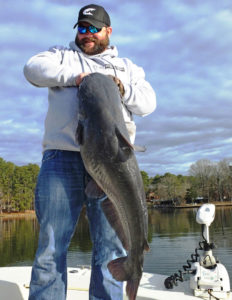
“It’s more than just having baits in the water. Time on the water encompasses finding and keeping up with big fish movements,” Royce said. “Generally, I like the lower end of Lake Gaston for cold-weather catfish. But I’ll move if conditions dictate.”
Royce said the next component is having the right bait in the right place.
“The right bait can be a moving target for trophy catfish,” he said. “I think it’s crucial to use bait that catfish already prefer for a consistent bite. For Lake Gaston, I’ve found that white perch and gizzard shad are my two basic ‘go-to’ baits in cold weather. The presentation may change, so I fish a variety of baits, including live, cut chunks, whole heads and fillets from perch or gizzard shad until I find a pattern for that day. From a generic standpoint, blues are predictable eaters. But they are sometimes picky. So I also experiment with large and small baits. Large baits can be great, but sometimes smaller baits trigger big fish bites.”
Royce has a drift-fishing game plan and does not do random drifts.
“Random drift-fishing is not consistent,” he said. “On Lake Gaston I target points, humps, ledges, channels and creek and river junctions as predictable contact areas during the winter. I look for forage in the area and big fish marks on my graph.”
Royce said he primarily drifts for blues during the winter and prefers to use his electric motor to keep the boat exactly where he wants it. His favored wintertime speed is around 0.4 to 0.6 miles per hour.
Santee Cooper: Moultrie, Marion
The Santee Cooper lakes, Marion and Moultrie, have produced insanely good winter action on blue cats for years, and that pattern continues. Good numbers of fish in the 5- to 15-pound class are available, as well as giant blues. The lakes have solid populations of hefty flatheads and channel catfish. But blues are by far the top winter target.
Guide Linwood Thornhill (843-509-8174), who works out of Blacks Camp on the Diversion Canal between the lakes, said both lakes are productive. But he generally opts for Lake Moultrie during cold months when weather allows. Having access to both lakes does enhance his opportunity for success.
“Wind and strong fronts can make Lake Moultrie difficult to fish because it’s so wide open. But when that occurs, the lower end of Lake Marion often provides shelter from certain wind directions and excellent winter fishing,” said Thornhill. He believes you can target big cats by looking for big-fish marks on your graph.
“Even when drift-fishing, I want to see catfish targets on the graph,” he said. “If I find catfish loaded in a general area, drift-fishing can be awesome.”
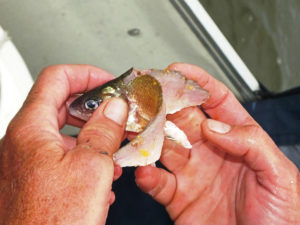
Thornhill said the key in every instance is being around a lot of baitfish. Depths will vary, but in December and January, he finds catfish in 25 feet of water — but also as deep as 40 to 55 feet on Lake Moultrie. Fish are generally shallower on Lake Marion. As the water temperature drops, forage patterns change, and he’ll adjust accordingly.
“To target really big catfish in cold weather, I like to stay in the deeper water,” he said. “Sometimes that’s difficult, because drifting shallower water we frequently find fast action. It’s not uncommon to catch a cooler of decent-sized catfish weighing 5 to 15 pounds apiece. But the best odds for hooking a trophy catfish are drifting in the deep water.”
Thornhill uses a wide variety of baits, but cut mullet, white perch, herring and shad all produce well.
“I give the fish options to determine what’s best on a daily basis,” he said. “Catfish will bite a lot of different baits, but sometimes big catfish can be finicky, so I’ll lay out a buffet for them.”
Lake Norman
North Carolina’s Lake Norman is red hot for blue catfish and is loaded with excellent numbers as well as heavy, top-end sized catfish.
Chris Nichols, who guides for catfish on several lakes in both Carolinas, calls Lake Norman his home lake. He said winter patterns are not difficult to understand.
“Two patterns develop during cold weather, and the key to both is the location of forage,” said Nichols (www.thecarolinaangler.com). “In the winter, a lot of forage moves into the larger creeks throughout the lake.
“A perfect scenario is a steady wind from one direction for a couple of days. That usually loads forage in the downwind coves and flats, so those are specific targets to drift. If the area has a hump or point, blues will often gang up on that spot when feeding heavily, but often, it’s just a consistent bite over a general area. My drift speed is usually 0.6 to 0.8 miles per hour.”
Nichols added that his preferred depths are usually in the 15- to 25-foot range at time of the year. Occasionally, when the wind pushes bait back far in a cove or pocket, he’s caught some huge blues in water less than 10 feet deep.
Nichols said a very productive deep-water pattern also develops.
“Not all the forage goes to the creeks; a lot of forage moves to deep water, and a significant segment of the catfish population follows,” he said. “Catfish will stack up in the mouths of main creeks in water ranging from 30 to 60 feet deep. These fish group in clusters, and they will typically be near the bottom, but the forage often suspends 10 feet or more off the bottom. I’ll typically drift-fish this target but move slower, usually about 0.5 miles per hour.”
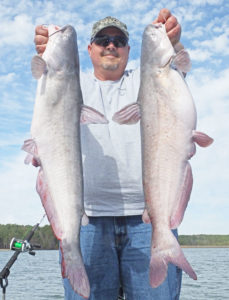
Nichols said December through March ranks high as a time to catch a trophy blue. The big-fish bite is more predictable, and blues up to 30 pounds are not uncommon; plenty of 5- to 10-pound cats are landed.
“Lake Norman has some huge catfish, but you can’t expect to hook up with those fish on every trip,” he said.
Nichols’ preferred bait is gizzard shad, but white perch are very productive winter baits.
“Typically, I’ll drift with six rods, and I bait a couple rigs with 4- to 6-inch whole gizzard shad for big fish and use 2-inch chunks of cut gizzard or perch on other rods.”
Lake Murray
Catfishing is productive and popular year-round at Lake Murray, but December and into the New Year is prime time for excellent action on blues, with an ample number of chunky channel cats caught as well.
William Attaway, who guides for catfish on several lakes, focuses on Lake Murray during the winter for blues, but the big population of channels ensures catches in good numbers.
“It’s definitely my favorite time of the year on Lake Murray to consistently catch big blues,” Attaway said. “While targeting blues, the same tactics will enable us to catch a number of channel catfish, most in the 5- to 10-pound class. We’ll have a mixed bag of catfish most days, and many of the blues will be 10 pounds or better, and it’s not unusual to catch them in the 20- to 30-pound class and occasionally much larger.”
Attaway (803-924-0857) will primarily drift-fish, and his primary focus will be upper end of the lake, from Dreher Island upstream. His primary targets are points, ledges, humps and channels.
“Regardless of the specific target I’m fishing, I use my electronics to find forage in the area first,” said Attaway, who uses a typical drift rig with an 8/0 Gamakatsu circle hook, 40-pound Berkeley Big Game for his main line and a 50-pound monofilament leader. He places a 2-inch float on the leader about 18 inches above the hook to keep the bait off the bottom.
“I’ll use different weights depending on the depth fished, but usually 1 to 2 ounces works,” he said. “I’ll fish from 25 feet down to 45 feet at times. My favorite baits during the winter are gizzard shad, blueback herring and white perch.”
Attaway said the best speed to drift on Murray during the winter will vary from 0.4 to 0.7 miles per hour.
“I vary the speed each day until I get that figured out,” he said. “Some days, it makes little difference as long as it’s in that range, but on some days, the exact speed can be a real key to success. Being near the edge of the creek or river or actually in the channel is important on most days.”


